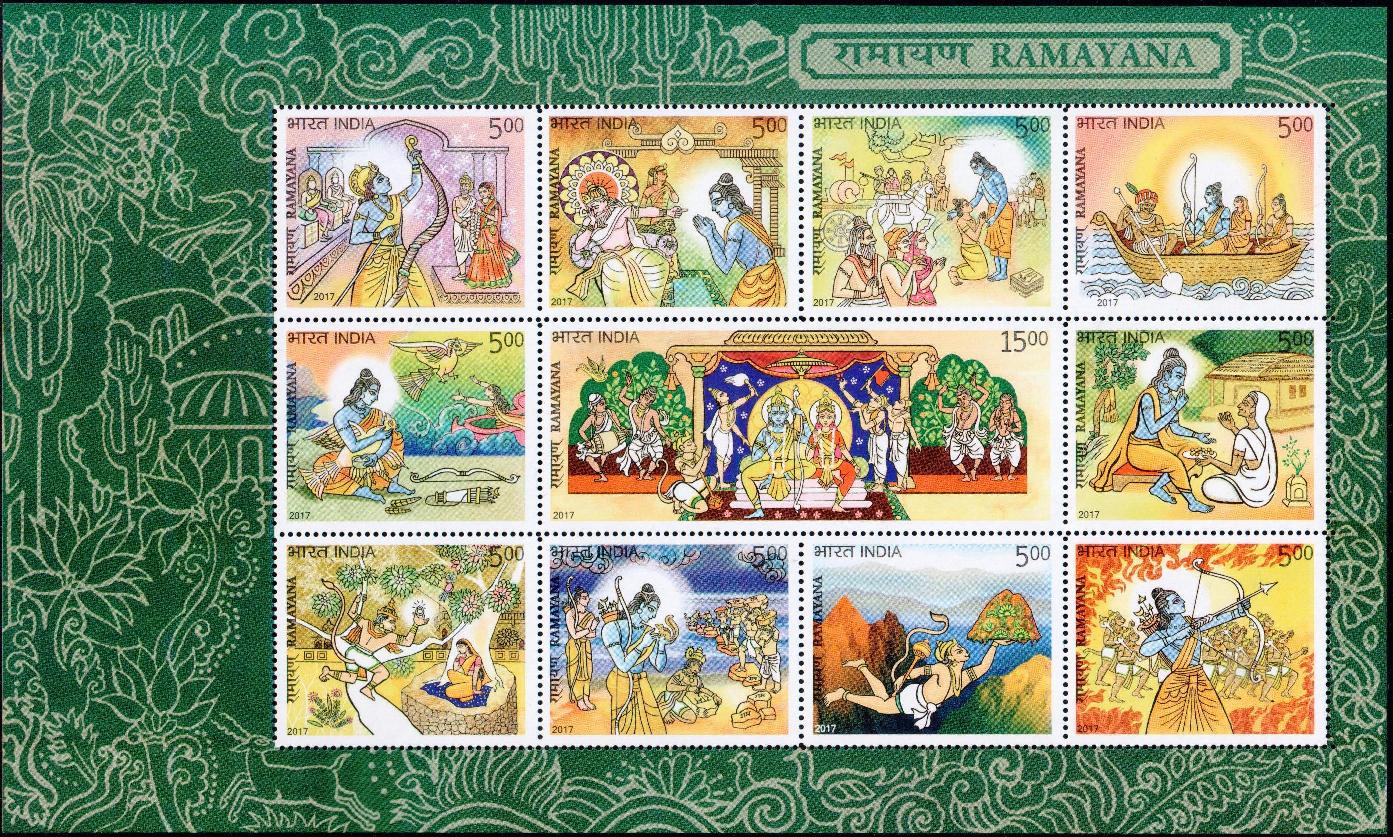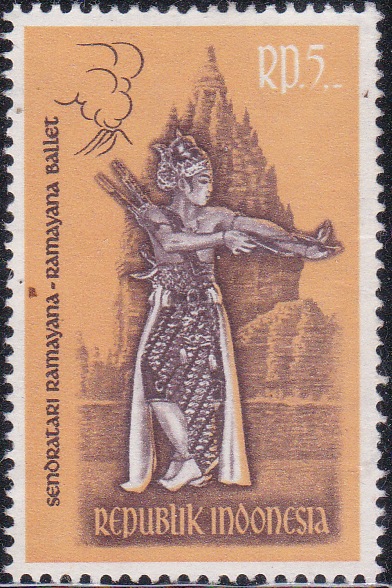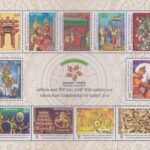
Ramayana
A Miniature Sheet and Sheetlet consisting of 11 nos. of special postage stamp on the Ramayan, an ancient Indian Sanskrit epic written by Maharshi Valmiki :












 Issued by India
Issued by India
Issued on Sep 22, 2017
Issued for : India Post is pleased to release a set of eleven stamps depicting significant instances from Ramayana.
Credits :
Stamp/Miniature Sheet/Sheetlet/FDC/Brochure : Sh. Sankha Samanta
Cancellation Cachet : Smt. Alka Sharma
Type : Miniature Sheet, Sheetlet, Mint Condition
Colour : Multi Colour
Denomination : 1500 Paise (1), 500 Paise (10)
Miniature sheets printed : 3.0 lakh
Sheetlets printed : 7.0 lakh
Printing Process : Wet Offset
Printer : Security Printing Press, Hyderabad
About :
- “Ram”, a chant, a magic word, the divine personified, the omnipresent who is there in every grain of sand, a noble king, a gentle prince, the blue deity who roamed across the country carrying the people of different cultures along. Ramayana, the story of Ram composed first by Valmiki around 500 b.c., has possibly many retellings before that as well as afterwards. Such is the power and the appeal of this simple story, but a story of a hero who suffers many adversities in life, which remains, to this date, unsurpassed. The story is loved by the millions not only in India, but now, practically all across the globe. Early migrants to Surinam, Fiji, Guiana, Mauritius etc. carried the story in their hearts that sustained them away from their beloved motherland. Many Asian countries such as Burma, Indonesia, Cambodia, Laos, Philippines, Thailand, Malaysia and Vietnam have adopted and internalized the story giving them local flavours. Within the country also different cultural and ethnic groups have lovingly adopted this story, adapted to the local cultural frameworks, selectively highlighting certain events or characters in their narratives and thereby enriching the great Ramayana tradition. While Valmiki Ramayana is in Sanskrit and follows a simple narrative, there are other versions in different languages such as Aadhyatm Ramayana supposedly composed by Vyasa, Kamba Ramayana written by poet Kambar in 12th century in Tamil, Krittivasi Ramayana written by Krittibas Ojha in Bengali etc. But the most overwhelming popular has been the Ramcharitmanas written by Tulsidas in 15th Century in Awadhi. Tulsi Ramayana or Ramcharitmanas emphasizes the supreme human qualities, the power of devotion or bhakti and the importance of the popular social norms and proper conduct etc. The focus is more on how the righteous carries out his duties.
- The basic storyline, as narrated by Valmiki is the story of Ram, the prince of Ayodhya who practices the ideal code of conduct. The progressively nuanced story of Ramayana has many instances that reflect upon equanimity and mental equipoise depicting Ram as ‘Maryada Prushotam Ram’.
- Maharishi Vishwamitra takes Ram and Laxman as his disciples teaching them the intricacies of using various arms and weapons. One day they reach Mithila. The king, Janak, came to welcome them and he was spell-bound by the radiance of the two Ayodhya princes. They were shown the ‘Shiva-dhanush’ which was kept in an iron case. King Janak and his wife Sunaina had announced that they would marry their daughter Sita to anyone who could mount the arrow on the ‘Shiva-dhanush’. Ram did this effortlessly. King Janak’s happiness knew no bounds and he married his beautiful daughter, Sita to prince Ram.
- King Dashrath wished to declare Ram as the ‘Yuvraj’ or the ‘Crown prince’ of Ayodhya. But, Manthara, the maid of queen Kaekeyi, felt that king Dashrath had been partial in his decision and she poisoned the mind of her mistress. Kaikeyi came under her influence and demanded that, Bharat, her own son should be made the future king of Ayodhya. Her second wish was, the banishment of Ram from Ayodhya for fourteen years. King Dashrath was crest-fallen but, was unable to persuade Kaikeyi to change her mind. Ram was devoted to his father and left Ayodhya accompanied by his wife, Sita and his brother, Laxman.
- Ram, Sita and Laxman had found shelter in Chitrakut. Bharat soon reached Chitrakut and begged Ram to return to Ayodhya while also informing Ram about the sad demise of their father. Ram was firm on his decision not to return to Ayodhya before fourteen years. Bharat requested Ram to give his ‘wooden paduka’ which he would keep upon the throne for fourteen years.
- Kewat was the boat man who ferried people across the holy river Ganga. It was in his boat that Ram, Sita and Laxman crossed the river. Shabari was the disciple of sage Matang who lived near Pampa lake. She was old and sick and her only desire was to meet Ram before dying. She was overwhelmed to see Ram in her hut and out of sheer love, she fed him sweet berries after tasting them.
- Later, due to unfortunate turns of events, Sita was taken forcefully by Ravana, the king of Lanka. The valiant bird ‘Jatayu’ answered to her screams by attacking Ravana’s chariot but Ravana cut off his wings. Wounded, he fell to the ground and struggled to keep alive. He died after informing Ram about the catastrophe.
- Hanuman was sent to search for Sita in Lanka. He took a leap towards the sky and flew towards Lanka. He saw her in Ashok Vatika and appeared before her cautiously and carefully introducing himself. He showed a ring of Ram to gain her trust. Sita was overwhelmed and had tears of joys in her eyes.
- After conquering Lanka, Ram entered to Ayodhya and ruled over for a long time. During ‘Ram Rajya’, Ayodhya became very prosperous. There was no sorrow. People were healthy and happy. Ram was an able king who believed in justice and equality. In the “Uttar Kand” of Tulsidas’s Ramcharitmanas and in Bhasa’s Uttar Ramcharit the story further progresses depicting Sita’s life in the jungle in the ashram of the sage Valmiki.
- Ramayana is a story of Maryada Purushottam Ram, upholder of righteous values of Dharma. This is a story of an ideal king, a noble ruler, a protector of social values and above all of a brave and gentle person. The story has been told and retold in different times and different places. The inspiring, empowering and enchanting story will enthral millions for all times.
- Text : Based on the material available on internet.








How and where can I purchase these
Where i can purchase these
[…] the moral and social awakening of the highest values of Indian tradition, thought and culture. The Ramayan, the Geeta and the Upnishads were published by him in the original Sanskrit text with a rendering […]
[…] and enduring bond build on trust, respect and tolerance for diversity. Among these linkages, is the Ramayana, the ancient Indian text, that has its representations and interpretations in variety of dance, […]
[…] month of Kartika in the traditional calendar. The festival of Diwali also marks the happy return of lord Rama to Ayodhya after fourteen year’s exile. It is a festival of lights and festivities. It comes off […]
[…] Ramayana in Telugu is very popular among the masses because, it is in simple and beautiful language. […]
[…] to Ramayana, King Janaka had built an exquisitely beautiful Vivaha Mandap (Pavilion), decorated with celestial […]
[…] poetry. This includes his two epics – “Ram Yashorasayan“, (based on the story of Ram) and “Pandava Yashorasayan” (based on the Mahabharat). Most of his compositions are […]
[…] Gandhi, Pt. Madan Mohan Malaviya and Ramdhan Pavde also moulded his character and ideas. The Ramayana, Mahabharata and holy Scriptures also had a formative influence upon […]
[…] which is amply displayed in all his works. Venkataramana Bhagvathar’s Kritis espouse Bhakthi, Rama Nama Prabhava and Vedantic philosophy. His compositions are found to be excellent pieces, highly […]
[…] the outstanding universities of the South. Sastri was a great scholar of Sanskrit. His lectures on Ramayana are enduring monuments of […]
[…] flows west, crosses the Kashmir border near Batalik and enters Pakistan. The ancient epic ‘Ramayana’ gives the title ‘Mahanadi’ to Sindhu, to denote ’the mighty river’. In the […]
[…] the traditional dance-drama are usually derived from Puranic mythology and popular epics like the Ramayana and the Mahabharata. In these dance-dramas, masks are used by the players to depict demons and […]
[…] Sage Valmiki is the reputed author of the most popular Sanskrit epic – Ramayana. He is stated to be a contemporary of Rama, the hero of his epic. Ramayana is called the Adikavya […]
[…] mention in Indian classical literature and scriptures dating back to 2000 BC, including the “Ramayana“, the poetry of Kalidasa, as also Buddhist texts which attribute it to the Bodhisatva […]
[…] festival commemorates the victory of Rama, over Ravana, the ruler of Lanka, who according to the Ramayana had abducted Sita, wife of Rama, and held her captive. The festival is celebrated with much gusto. […]
[…] yellow flowers, covered with soft white hair, scattered on the stalk. Sal finds mention even in the Ramayana and Mahabharata and in Kalidasa’s ‘Ritu-samhar’ and […]
[…] joint family of those days. Through tradition, Phalke was already well-versed in the great epics, Ramayana and Mahabharata in his childhood and also had studied Vedas, Upanishadas, Shastras and Puranas, […]
[…] renown rests on his monumental Tamil epic, the Kamba Ramayana. It is essentially the story of Rama retold in Tamil. Though the theme is the same as that of the original work of Valmiki in […]
[…] ancient India whose references come in Puranas and other historical documents. The Mahabharata and Ramayana, both include him in pivotal roles including being guru to Bhishma, Dronacharya and Karna. He […]
[…] and ceiling are emblazoned with terracotta sculptures portraying Krishna Leela, episodes from the Ramayana and Mahabharata, and the socio-economic and political life of the people of the […]
[…] deals with general public life in Aryan and non-Aryan India, Gandhian philosophy, stories of Lord Rama and modern contemporary thinking. Personal essays are a fundamental feature of his writing. All the […]
[…] literally means ‘rows of lamps’. Deepavali commemorates the return of Lord Rama, along with wife Sita and younger brother Lakshmana, from his fourteen-year long exile after […]
[…] has studied the Sangam literary works, Silappadhikaram and Manimealai and also our epics like Ramayanam and Mahabharatham. Well versed in the art of warfare. This was the tradition followed by the family […]
[…] Sita-Rama as an indivisible personified expression of compassion and love, sacrifice and selfless service unflinching dutifulness and action without attachment, truth and self-dignity and also transcendent knowledge and bliss is worthy of worship and meditation not only for the Hindus but for the entire mankind. […]
[…] like Bhima and Karna. Balram, brother of Lord Krishna was a renowned wrestler of his times. In the Ramayana there is mention of King Bali of Vanaras, having won against the mighty Ravana, the King of Lanka […]
[…] wash. Later, he worked in tempera. His mastery of the Indian tradition is reflected in the ‘Ramayana scenes‘, ‘Nala-Damayanthi‘, ‘Agni‘, etc., while his own […]
[…] for participating in the Satyagraha movement. During imprisonment he translated the “Balmiki Ramayan” into Oriya and produced the Oriya prose version of “The Bhagwad Geeta“. In 1932 […]
[…] “Kagvani” in eight volumes consisting of couplets, devotional songs, episodes from the Ramayana and Mahabharata and songs based on Gandhian philosophy and the Bhudan Movement. Often these are […]
[…] caretakers of the passage across the sea from Rameshwaram to Sri Lanka, built as per the legend, by Lord Rama, and of the Ramlinga Idol. They considered themselves not only the rulers of the State of […]
[…] went on to act in leading roles in more than 320 films. His mythological characters, particularly Lord Rama and Krishna remained in the hearts of people who even worshipped NTR as living God. A […]
[…] is famous for its charming meadows of alpine flowers. Legends believe it to be the place from where Hanuman collected the Sanjeevanibuti for curing Laxman. This National Park has floral pastures, running […]
[…] expression it enjoys folk liberty. It is a whole night performance depicting the stories of the Ramayana, the Mahabharatha and the Puranas. Yakshagana is a kind of ritualistic Theatre art. It is […]
[…] means Shri Ram is Dharma incarnate. Maharishi Valmiki called Shri Ram ‘Dharmavigrah’ in Ramayana, God incarnated for the welfare of the people. Maharishi Ved Vyas said that the incarnation of Shri […]
[…] of his little education, he had read a good number of books like Raguvamsham in Sanskrit, Tulasi Ramayana in Awadhi, etc. and mastered them. He was also able to read Bengali magazines and newspapers. Due […]